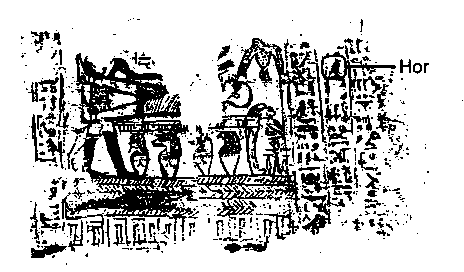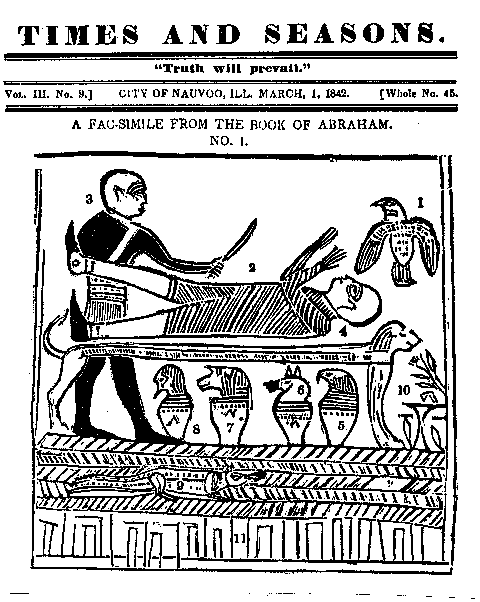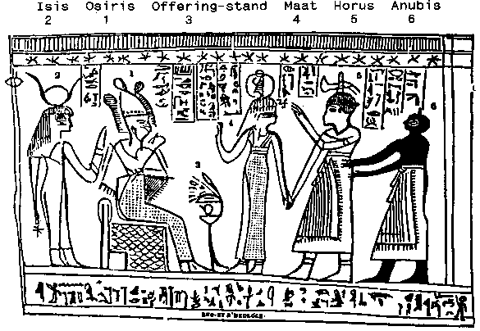

Aabrahamin kirjan tutkintaa jälleen |
| In the year 1835 at Kirtland, Ohio, Joseph Smith, Jr., leader of
the Church of the Latter Day Saints, dictated what he claimed was
a translation of an ancient Egyptian papyrus containing the writings
of Abraham. Through the years, whenever the Book of Abraham was
printed there were included with the printed text three drawings,
each designated as a "facsimile" from this alleged Book of Abraham.
In recent years the truth of such claims was shattered when some
of the actual Egyptian papyri which Joseph Smith had in his possession
were rediscovered and given to the LDS church. What does one do
when what was represented to be Abraham's writings turns out to
be totally unsupported by what is written in the Egyptian characters?1 The early LDS church leaders repeatedly claimed that the Egyptian text contained the actual writing of Abraham. When William W. Phelps, as a scribe for Joseph Smith, was writing in the latter part of 1835, he recorded that the record was a "Translation of the Book of Abraham written by his own hand upon papyrus and found in the Catacombs of Egypt."2 These words formed a preface in the Phelps manuscript to the opening portion of Joseph Smith's Book of Abraham (1:1 to 2:18) and clearly assert that the text that followed was Abraham's own writing.3 When the church headquarters was moved to Nauvoo, Illinois, the LDS Quorum of the Twelve Apostles was given the responsibility of managing the church publication called the Times and Seasons. Wilford Woodruff, who was the business manager at the time, recorded in his diary that Joseph the Seer has presented us some of the Book of Abraham which was written by his own hand but hid from the knowledge of man for the last four thousand years but has now come to light through the mercy of God4Accordingly, the Quorum of the Twelve issued an announcement in their periodical that the church wanted tithes sent to Nauvoo for publications, including "the record of Father Abraham."5 When Joseph Smith himself took over as editor of the Times and Seasons he dictated an article recorded by his scribe, Willard Richards, which stated in part: A considerable quantity of the matter in the last paper was in type before the establishment came into my hands. . . . In the present no. will be found the commencement of the Records discovered in Egypt some time since as penned by the hand of Father Abraham which I shall continue to translate & publish as fast as possible till the whole is completed. . . .6 Only a small portion of this article was published, along with
a notice to subscribers of the paper that Joseph Smith now became
responsible for the publication's contents as the editor of the
Times and Seasons.7 For Wilford Woodruff and the
Latter-day Saints in Nauvoo, there was no question that the long
awaited papyri writings which Joseph Smith had and was working on
would soon be published and made available to members of the church
and to all the world through their Times and Seasons press. A Translation of Some ancient Records that have fallen into our hands from the Catacombs of Egypt, purporting to be the writings of Abraham, while he was in Egypt, called the Book of Abraham, written by his own hand upon papyrus. THE BOOK OF ABRAHAM.8This descriptive heading was then published in the Times and Seasons along with the opening portion of the text that was represented to be a book actually written by Abraham himself.9 In three separate issues of the church paper individual reproductions or "facsimiles" from this "Book of Abraham" record were printed from woodcut illustrations made by Reuben Hedlock. Mormon scholar Edward H. Ashment has demonstrated that these original woodcut drawings of Facsimile No. 1 (the lion-couch scene) and Facsimile No. 2 (the round hypocephalus) were not copied correctly in all details and include some incorrect restorations in damaged areas of the original papyrus.10 In the month of May 1844, Josiah Quincy and Charles Adams visited Nauvoo and viewed the Egyptian mummies and talked to Joseph Smith about the records. Charles Adams recorded in his diary: He [Joseph Smith] then took us down into his mother's chamber and showed us four Egyptian mummies stripped and then undertook to explain the contents of a chart or manuscript which he said had been taken from the bosom of one of them. The cool impudence of this imposture amused me very much. "This," said he, "was written by the hand of Abraham and means so and so. If anyone denies it, let him prove the contrary. I say it." Of course, we were too polite to prove the negative, against a man fortified by revelation.11From Adams and others who viewed the mummies and asked about the age of the manuscripts obtained with them it is clear that Joseph Smith and the early Mormons represented the Book of Abraham to have been penned by the very hand of Abraham himself. After Smith's death in June 1844, Franklin D. Richards published a pamphlet in July 1851, entitled, The Pearl of Great Price. In this publication was printed the little Book of Abraham, together with the three facsimile illustrations. About five years after the three facsimiles were published in the Pearl of Great Price a young Egyptologist by the name of M. Theodule Deveria, who was working at the Louvre Museum in Paris, France, was asked to examine these facsimiles and comment on as much of the poorly copied Egyptian characters as could be deciphered. In commenting about Facsimile No. 3, Figure 5, he wrote: The deceased led by Ma into the presence of Osiris. His name is Horus, as may be seen in the prayer which is at the bottom of the picture, and which is addressed to the divinities of the four cardinal points.12Deveria was the first Egyptologist to note that what Mormons had published as a "Facsimile from the Book of Abraham" was really a funeral illustration for a corpse named Horus. Later, when the mummies and papyri which Joseph Smith had owned were sold to the St. Louis Museum and put on display, Professor Gustavus Seyffarth, who had devoted considerable study to Egyptian, was also able to read the name of the person for whom Facsimile No. 3 was made. The following mentions his visit and observations: . . . according to Prof. Seyffarth, the papyrus roll is not a record, but an invocation to the Deity Osirus, in which occurs the name of the person, (Horus,) and a picture of the attendant spirits, introducing the dead to the Judge, Osirus.13 In 1873 T. B. H. Stenhouse published his book, The Rocky Mountain
Saints: A Full and Complete History of the Mormons, which republished
Deveria's study of the Book of Abraham facsimiles. His book was
republished four times by the year 1905.14 This
helped to circulate more widely the information that the Book of
Abraham material really was funerary in nature and that Facsimile
No. 3 was made for an Egyptian named Horus. Original of Facsimile No. 1 Dr. Klaus Baer was the first person to publish a translation of the writing flanking the original of Facsimile No. 1. The following translation starts from the outer right-hand column and identifies it as an illustration intended to accompany the "Breathing Permit" written for a deceased named Hor(us), son of Tikhebyt:
Lines 1-3 give the titles, name, and parentage of the man for whose benefit the Breathing Permit was written:Dr. Baer also gave a helpful explanation of the figures on the drawing made from the papyrus. The numbers in parentheses are those on Facsimile No. 1 published by Joseph Smith, added by Dr. Baer to facilitate comparison with Smith's comments upon various parts of the drawing: The vignette shows the resurrection of Osiris (who is also the deceased owner of the papyrus) and the conception of Horus. Osiris (2) is represented as a man on a lion-couch (4) attended by Anubis (3), the jackal-headed god who embalmed the dead and thereby assured their resurrection and existence in the afterlife. Below the couch are the canopic jars for the embalmed internal organs. The lids are the four sons of Horus, from left to right Imset (8), Hapt (7), Qebeh-senuwef (6) [5], and Duwa-mutef (5) [6], who protect the liver, lungs, intestines, and stomach, respectively. At the head of the couch is a small offering stand (10) with a jug and some flowers on it and two larger vases on the ground beside it. The ba of Osiris (1) is hovering above the head.20 Facsimile No. 2 Michael Dennis Rhodes, a Mormon scholar skilled in Egyptian, has translated the hieroglyphic writing of Facsimile No. 2, a copy of an Egyptian hypocephalus, so-called because it was usually placed under (hypo-) the mummy's head (cephalus). Edge [Figure 18]: I am Djabty in the House of the Benben in Heliopolis, so exalted and glorious. [I am] a copulating bull without equal. [I am] that Mighty God in the House of the Benben in Heliopolis . . . that Mighty God. . . . Left Middle [Figures 11, 10, 9 and 8]: O God of the Sleeping Ones from the time of the Creation. O Mighty God, Lord of Heaven and Earth, the Netherworld and his Great Waters, grant that the soul of the Osiris Sheshonk, may live. Bottom [Figures 17 and 16]: May this tomb never be desecrated, and may this soul and its possessor never be desecrated in the Netherworld. Upper Left [Figures 21, 20 and 19]: You shall be as that God, the Busirian. To the Left of the Standing Two-headed God [Figure 2]: The name of this Mighty God.21 This translation makes it clear that the material does not relate to Abraham (or even to Horus as Facsimiles No, 1 and No. 3 do), but to a deceased named Sheshonk. Facsimile No. 3 Dr. Baer has also given an explanation of the figures on Facsimile No. 3, together with a reading of some of the hieroglyphs as far as he can recognize them from the woodcut copy."Facsimile No. 3" shows a man (5), his hand raised in adoration and a cone of perfumed grease and a lotus flower on his head (ancient Egyptian festival attire), being introduced by Maat (4), the goddess of justice, and Anubis (6), the guide of the dead, into the presence of Osiris (1), enthroned as king of the Netherworld. Behind Osiris stands Isis (2), and in front of him is an offering-stand (3) with a jug and some flowers on it. Over the whole scene is a canopy with stars painted on it to represent the sky. . . . The texts, poorly copied as they are, carry us one step further. As far as it can be made out, the lines of hieroglyphs below the scene read:The same name Hor or Horus which Prof. Seyffarth read in the 1850s and that Deveria read from the printed Facsimile No. 3 is now confirmed as being on that facsimile as well as appearing in one of the columns of hieroglyphics of the original to Facsimile No. 1. A portion of the original papyrus text which accompanied the illustrations used for Facsimile Nos. 1 and 3 was among the papyri recovered from the museum's archives.23 It contains the Egyptian characters that were copied down the left hand margin of the Book of Abraham Translation Manuscripts. It has also been translated by several scholars including Dr. Hugh Nibley, who has published a word-for-word translation of what all authorities agree are actually instructions for wrapping the mummy. inside (of) the lake great (of) Chonsu born of Taykhebyt justified likewise after clasp - ed (two) arms his upon breast his being as wrap - ed like a book (or roll . . .): the Book of Breathings . . . being written according-to-what is . . . in (the sacred) writing (Books) on both inside and outside in linen (of) the king One places (or is placed) arm left his vicinity of heart his, having-been-done this for his wrapping on (the) side outer If makes one for him book this, then breathes he like souls (of the) gods for time and eternity.24Dr. Baer's translation of the same text smooths out the stiffness of the Egyptian style into more flowing English, as follows: Osiris shall be conveyed into the Great Pool of Khons -- and likewise Osiris Hôr, justified, born to Tikhebyt, justified -- after his arms have been placed on his heart and the Breathing Permit (which [Isis] made and has writing on its inside and outside) has been wrapped in royal linen and placed under his left arm near his heart; the rest of his mummy- bandages should be wrapped over it. The man for whom this book has been copied will breathe forever and ever as the bas of the gods do.25From the above translations and explanations of the Egyptian writings and drawings scholars have determined that rather than giving a narrative story about Abraham, the texts indicate that they are funeral in nature.26 The LDS church should realize that identification of the Egyptian documents as the Book of Abraham and the canonization of it as scripture in years past is no reason to reject the identification of the rediscovered Egyptian papyri and published facsimiles are strictly Egyptian funeral texts. It is time accept the fact that the Egyptian papyri purchased by Joseph Smith are not authentic Abrahamic records recorded by the father of the faithful as was believed these many years. IllustrationsIllustration 1 - Beginning of original papyrus scroll designated as part of the Book of Abraham. 
Illustration 2 - Incorrect reconstruction of the beginning illustration of the original papyrus prepared for Horus. 
Illustration 3 - Ending of papyrus scroll prepared for Horus. Reconstruction designated as part of the Book of Abraham.

NOTES
|
